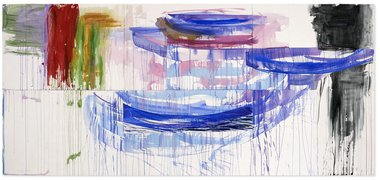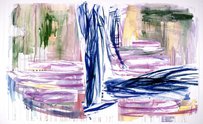John Hurrell – 23 December, 2024
By using collage in partnership with the manual properties of painting, Albrecht in the late eighties revitalised how we think about such normally unconnected methods, showcasing new edge-focussed working processes (where the outer perimeter is perhaps more important than the centre) and—through frenetic and lively juxtapositions—unexpected optical pleasures.
Titrangi
Gretchen Albrecht
Liquid States
A career survey curated by James Gatt
3 November 2024 - 2 February 2025
Looking through Liquid States in five rooms on the two upper floors of Te Uru gives you the chance of pondering Gretchen Albrecht’s working methods over several decades of very focussed painting production, the supports often being paper instead of canvas.
There are potentially a lot of varied mark-making methods to think about, but for me, it is the preparatory collages, drawings and prints that I found revelatory, particularly those experimenting with cut up surfaces bearing vigorous marks, where some elements (all painted on paper supports) are laid over others and pasted on—exploiting calculated juxtapositions at the clearly discernible shape edges. The material was new to me, even though much of it was presented in an earlier show (Collages 1988-1989) at Two Rooms in May 2020.
There are two works in Liquid States I find particularly engrossing and powerfully evocative. They are Torrent, 1988, a rectangular collage featuring overlapping cut-out sections of paint applied paper, and Receptum, 1988, presenting thin dribbly paint running down long parallel horizontal strips, one stacked immediately above the other.
They explore different contours, processes, tactilities, rhythms, densities and directional vectors. The one with double bands is stapled directly to the wall; the other framed and under glass. Both have lots of airy slashes and white fragments woven into alongside and behind the agitated gouache washes and churning flecks.
With Receptum, balanced by levitating blocks of sienna-red and turbulent black at opposite ends, a drama is created in the centre by three curved dribbly fibrous bars of dark blue (and another of shredded violet) bouncing around and advancing—mostly in the upper half. Mimicking pale ghostly forms, and anaemic wobbly stained streaks, hover on the verge of effortless participation.
In Torrent, feathery striated braids of blue first dramatically descend, compressed and compacted, and then traverse from left to right like a dark river, perhaps imprinted by a manic or drunken Massey-Ferguson, the artist’s brushmarks and slicing scissors co-ordinating in a gleefully stuttering sliding shuffle.
By using collage in partnership with the manual properties of painting, Albrecht in the late eighties revitalised how we think about such normally unconnected methods, showcasing new edge-focussed working processes (where the outer perimeter is perhaps more important than the centre) and revealing—through frenetic and lively juxtapositions—unexpected optical pleasures.
John Hurrell


 Two Rooms presents a program of residencies and projects
Two Rooms presents a program of residencies and projects Advertising in this column
Advertising in this column



This Discussion has 0 comments.
Comment
Participate
Register to Participate.
Sign in
Sign in to an existing account.